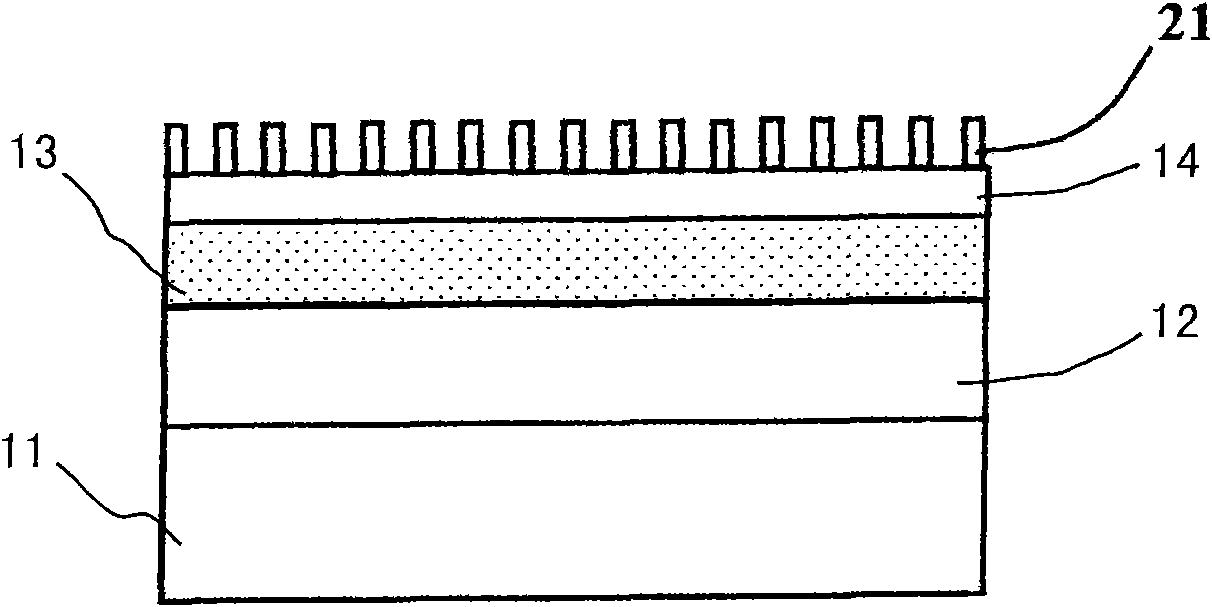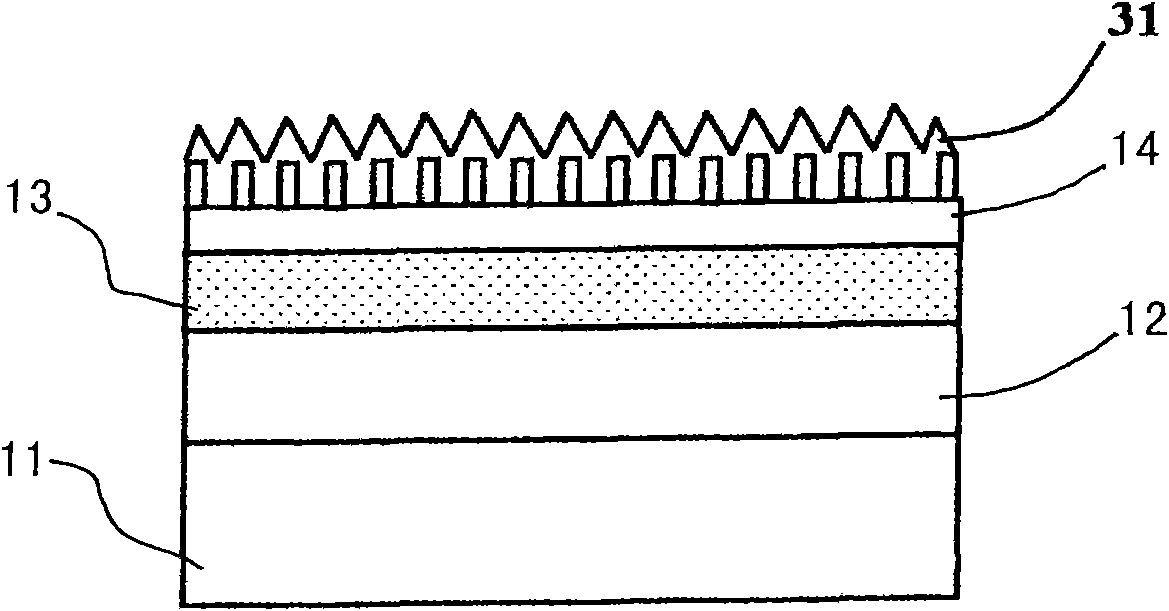Manufacturing method for surface roughening of GaN-based optoelectronic device
A surface roughening and electronic device technology, which is applied in the field of p-type layer roughening on the surface of photoelectric conversion devices, can solve the problem of reducing the conductivity type of the p-GaN layer, increasing the contact resistance between the electrode and the p-GaN, and the roughening effect is not ideal. and other problems, to achieve the effect of less surface defects and less chance of reflection
- Summary
- Abstract
- Description
- Claims
- Application Information
AI Technical Summary
Problems solved by technology
Method used
Image
Examples
Embodiment 1
[0036] Embodiment one: see Figure 1-Figure 3 shown. Use Metal Organic Chemical Vapor Deposition (MOCVD) method to epitaxially grow n-type layer 12, i-type layer 13, p-type layer 14 sequentially on substrate 11, wherein said substrate 11 is a sapphire substrate; n-type layer 12 is The n-type GaN epitaxial layer has a thickness of 3000nm; the i-type layer 13 is In 0.1 Ga 0.9 N / GaN multi-quantum well structure with a thickness of 60nm; the p-type layer 14 is a p-type GaN material with a thickness of 150nm; then deposit 200nm thick SiO on the p-type layer 14 2 Dielectric film; then in SiO 2 A layer of metal Ni is evaporated on the dielectric film, and the metal Ni is aggregated into metal islands with a diameter of about 10-200 nanometers by means of rapid annealing. Use the metal island as a mask material to etch the p-type layer 14 with an etching depth of 100nm, thereby producing the nano-column array 21; then, grow the p-type thick p-type layer on the surface of the epita...
Embodiment 2
[0037] Embodiment two: see Figure 1-Figure 3 shown. Use metal organic chemical vapor deposition (MOCVD) method to epitaxially grow n-type layer 12, i-type layer 13, p-type layer 14 sequentially on substrate 11, wherein said substrate 11 is n-type GaN substrate material; n-type Layer 12 is an n-type GaN epitaxial layer with a thickness of 300nm; the i-type layer 13 is In 0.1 Ga 0.9 N / GaN multi-quantum well structure with a thickness of 60nm; the p-type layer 14 is a p-type GaN material with a thickness of 150nm; then deposit 200nm thick SiO on the p-type layer 14 2 Dielectric film; then in SiO 2 A layer of metal Ni is evaporated on the dielectric film, and the metal Ni is aggregated into metal islands with a diameter of about 10-200 nanometers by means of rapid annealing. Use the metal island as a mask material to etch the p-type layer 14 with an etching depth of 100nm, thereby producing the nano-column array 21; then, grow the p-type thick p-type layer on the surface of t...
Embodiment 3
[0038] Embodiment three: see Figure 1-Figure 3 shown. Use Metal Organic Chemical Vapor Deposition (MOCVD) method to epitaxially grow n-type layer 12, i-type layer 13, p-type layer 14 sequentially on substrate 11, wherein said substrate 11 is a sapphire substrate; n-type layer 12 is The n-type GaN epitaxial layer has a thickness of 3000nm; the i-type layer 13 is intrinsic In 0.2 Ga 0.8 N layer with a thickness of 200nm; the p-type layer 14 is a p-type GaN material with a thickness of 150nm; then deposit 200nm thick SiO on the p-type layer 14 2 Dielectric film; then in SiO 2 A layer of metal Ni is evaporated on the dielectric film, and the metal Ni is aggregated into metal islands with a diameter of about 10-200 nanometers by means of rapid annealing. Use the metal island as a mask material to etch the p-type layer 14 with an etching depth of 100nm, thereby producing the nano-column array 21; then, grow the p-type thick p-type layer on the surface of the epitaxial wafer wit...
PUM
| Property | Measurement | Unit |
|---|---|---|
| thickness | aaaaa | aaaaa |
| thickness | aaaaa | aaaaa |
| thickness | aaaaa | aaaaa |
Abstract
Description
Claims
Application Information
 Login to View More
Login to View More - R&D
- Intellectual Property
- Life Sciences
- Materials
- Tech Scout
- Unparalleled Data Quality
- Higher Quality Content
- 60% Fewer Hallucinations
Browse by: Latest US Patents, China's latest patents, Technical Efficacy Thesaurus, Application Domain, Technology Topic, Popular Technical Reports.
© 2025 PatSnap. All rights reserved.Legal|Privacy policy|Modern Slavery Act Transparency Statement|Sitemap|About US| Contact US: help@patsnap.com



